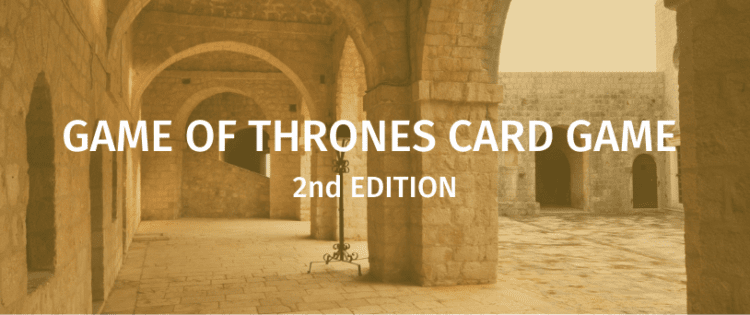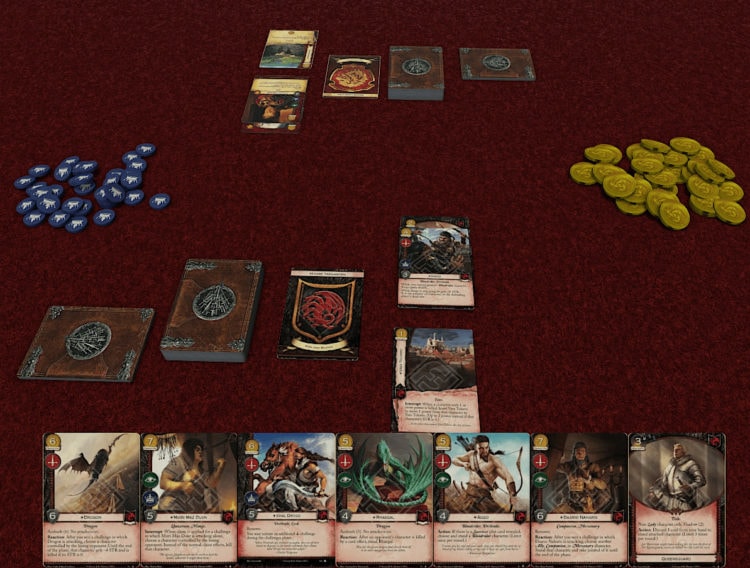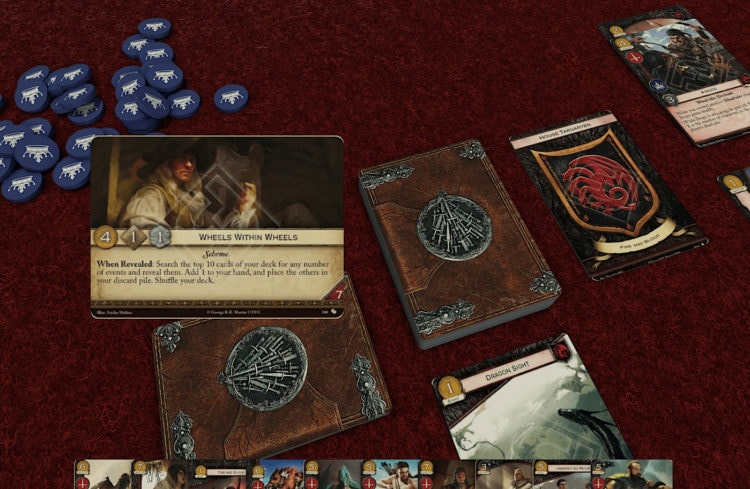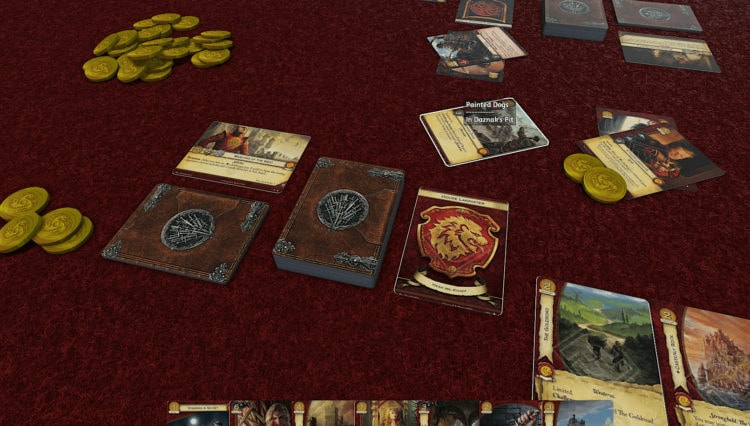
OBJECTIVE OF GAME OF THRONES THE CARD GAME 2nd EDITION: The objective of Game of Thrones The Card Game 2nd Edition is to win 15 power points before your opponent does.
NUMBER OF PLAYERS: 2 to 4 (6 with a second core set, or deluxe extensions)
MATERIALS:
Core set materials:
- 192 player cards
- 8 Faction cards
- 28 Plot cards
- 30 Power tokens
- 30 Gold tokens
- 10 Influence tokens
- 1 first player tile
- 6 Title cards (to play with more than 2 players)
TYPE OF GAME: strategic expert card game
AUDIENCE: teen, adult
OVERVIEW
In Game of Thrones: The Card Game, join the houses of Stark, Lannister, Targaryen, Baratheon, Greyjoy, Martell as they seek to seize the Iron Throne.
Game of Thrones: The Card Game is a game of intrigue, politics, betrayals and battles based on the novels of George R.R. Martin.
Each player embodies one of the factions that seek to influence and control the Iron Throne in order to seize power in Westeros. Each player has two decks of cards: a deck of draw cards, which feeds the forces at his disposal, and a deck of plots, which is used to develop a long-term strategy.
As the game progresses, players engage in military battles, court plots and power struggles until one of them is victorious.
This second edition was released in 2015 and is mostly identical to the first edition released in 2002. However, it has been slightly simplified, with a few rules being modified or removed, and all the cards have been redesigned, which makes this second edition a game on its own that cannot be combined with the first edition.
SETUP
Each player chooses a faction, which can be one of the 6 main houses or a neutral faction, and a deck from that house. A deck consists of:
- a House card, displaying the symbol of the chosen house
- an Agenda card (optional), which modifies certain rules in a global way
- a deck of at least 60 cards
- a deck of plots, of exactly 7 cards
Each player places his two decks in front of him, along with his house card, and then draws 7 cards from his draw deck. From these 7 cards he chooses any combination of Character, Attachment or Location cards whose total cost does not exceed 8, which will constitute his starting strength. He places them in front of him, face down. When each opponent has done the same, the players reveal their set-up cards, then complete their hand until they have 7 cards again.
Notes:
- Only one card with the “Limited” keyword may placed by each player during the setup
- Before placing his setup cards, each player may declare a single Mulligan if he has not a decent starting hand (for example, no characters or no locations is quite risky as a starting hand); if he does so, he shuffles his 7 cards with his deck and draws 7 new cards
- In the Core Set of the game four starter decks are provided but don’t respect some of the deckbuilding rules (they have less than 60 cards and do not respect the Loyal rule)

GAMEPLAY
Types of cards
House cards indicate the house controlled by each player. There is also a Neutral House card, which does not actually correspond to any house.
Agenda cards are strategic cards that profoundly change the way a deck works. A player can usually have one and only one Agenda card, placed next to his House card.
Plot cards are strategy cards that allow the player to momentarily influence the course of the game for the duration of a turn. A player must have exactly 7 Plot cards. Each Plot card has:
- in its top left corner, 3 icons representing, from left to right, the player’s income, initiative and claim (i.e. the damage he inflicts during challenges)
- in its bottom right corner, an icon representing the player’s reserve (i.e. the number of cards he is allowed to have in hand at the end of the turn when the plot is played)
- a text describing the plot’s effect, which may be permanent, triggered immediately (in which case it will be marked “when revealed”) or triggered subject to conditions (indicated in the text of the effect)
The Character, Location, Attachment and Event cards make up the player’s draw deck.
Characters, Locations and Attachments are permanent cards and have a recruitment cost in the top left corner, which must be paid in gold during the Marshalling phase of their owner. Conversely, Event cards are immediate-effect cards that can be played directly, including during other players’ turns, under certain conditions specified on the card.
The Characters:
- have a Strength value (shield icon), used during challenges and hegemony
- may have icons corresponding to the three types of confrontation that can take place: military, power and intrigue
- may have virtue icons (bottom right) used by some card effects: Warrior (crossed swords), Noble (ring), Scholar (open book) and Mystic (chalice).
Attachments are cards representing objects, conditions or other situations that apply to a Character or Location (or more rarely other types of cards). An Attachment is placed under the card to which it is attached.
Permanent cards also have a House icon with or without a small parchment placed under it. A card with such a parchment under its house symbol is Loyal and thus cannot be used in a deck whose House card is different from the card’s house symbol.
Other icons in the text box of the permanent cards:
- Gold: the value indicated represents an income bonus at the beginning of the Marshalling phase.
- Initiative: the value indicated in the diamond represents a bonus applied when determining the initiative in the Plot phase.
Course of the game round
A game round is divided into 7 successive phases
- Plot phase
- Draw phase
- Marshalling phase
- Challenges phase
- Dominance phase
- Standing phase
- Taxation phase
1. Plot phase
Each player consults his pile of plots freely and secretly chooses a plot to activate during the turn. When all players have chosen, the plots are revealed simultaneously:
- the plot revealed by each player is placed on top of his pile of used plots
- the player with the best initiative (that of his plot + plus that of his other cards in play) chooses who will be the first player in the round (in case of a tie, the player with less Power wins initiative)
- any “when revealed” effects that may be present on the plots revealed are applied, starting with designated first player and going clockwise

2. Draw phase
Each player draws two cards from his or her deck.
3. Marshalling phase
Starting with the player designated as the first player during the plot phase, then clockwise, each player will:
- take his income: receive from the bank as many gold coins as indicated on his plot and other cards in play
- play as many permanent cards from his hand as he wishes by paying their cost in gold
Note: cards that bring in gold will only add gold to a player’s income on the turn following the turn they are played.
4. Challenges phase
During this crucial phase of the turn, players will, always in turn order, challenge other players in one or more of the three areas of confrontation: military (red axe icon), power (blue crown icon) or intrigue (green eye icon).
How a challenge is done:
- the active player (called the attacker) declares the type of challenge (military, power or intrigue) and the targeted player (called the defender)
- the attacker declares one or more attacking characters (which must have the icon of the type of challenge declared) and kneels them
- for each participating character having the keyword Stealth, the attacker designates a defender character who does not have the keyword Stealth, to prevent that character from being declared defender
- the defending player declares (or not) defending characters (which must have the icon of the type of challenge declared) and kneels them
- resolution: the combined strength of the attacking characters is compared with that of the defending characters, and if the attacker has greater or equal strength, he wins the challenge.
- application of losses: if the attacker has won the challenge, he inflicts a number of losses equal to the claim value of his plot card, the nature of which depends on the type of challenge
- military challenge: the defender chooses as many characters under his control, participants in the challenge or not, and places them in his pile of the dead
- challenge power: the attacker moves as many Power tokens from the defender’s House card to his House card (if there are not enough, he completes by taking from the reserve)
- challenge intrigue: the attacker randomly draws as many cards from the defender’s hand and places them in the opponent’s discard pile.
- in addition, and regardless of the type of challenge, if the defender’s strength was 0, the challenge is considered unopposed, and in this case the attacker takes an extra Power token from the reserve and places it on his House card
- whoever wins the challenge, his participating characters with the keyword Renown each take a Power token (on themselves)
- whoever wins the challenge, that player discards one card from the loser’s deck for each of his participating characters with the keyword Pillage
- whoever wins the challenge, that player draws one card for each of his participating characters with the keyword Insight
- if the attacker won the challenge with one or more characters having the Intimidate keyword, he may choose any character controlled by the defender, whose Strength is lower or equal to the difference in Strength by which he won, and kneel that character
The active player can declare one and only one challenge of each type, hence three challenges total, before passing the hand to the next player clockwise.
Other rules for challenges:
- if the defender wins the challenge, he does not apply his plot’s claim
- a character who has been kneeled (e.g. to participate in a previous challenge) cannot be kneeled again to participate as an attacker or defender in a challenge
- the characters with the keyword Vigilant (Baratheon house) stand up when they have won a challenge in attack
- characters with the keyword Vindictive (Martell house) stand up when they have lost a challenge in defence

he declares an Intrigue challenge with Tyrion Lannister, thus earning two gold thanks to Tyrion’s text, and wins unopposed as the Targaryen has no Intrigue characters
he then plays Painted Dogs from his hand thanks to their Ambush (4) keyword and declares a Military challenge; the Targaryen player defends with his Jhogo and wins, thus avoiding Jhogo’s death
the Lannister player then brings back the Painted Dogs in his hand thanks to their text, standing Tyrion Lannister in the process
thanks to Casterly Rock, he declares another challenge with Tyrion Lannister, thus earning two more gold, and wins again unopposed
finally, he is again able to play the Painted Dogs from hand as he has 4 Gold again
in total, the Lannister has earned two Power tokens, discarded two cards from his opponent’s hand and forced his opponent to kneel his only character
However, the Targaryen player has put a card into shadows, which is an attachment allowing to stand the attached character! Targaryen will have his revenge…
5. Dominance phase
During this phase, each player adds up his gold left over with the strength of his standing characters. The player with the highest score wins the dominance and places one Power token from the reserve on his House card.
6. Standing phase
Players simultaneously stand all their kneeled cards.
7. Taxation phase
Players who still have gold place it back in the bank. Then all players check whether or not they have more cards in hand than their plot card’s reserve value. If they have more, they must discard cards from their hand to match their plot’s reserve value.
OTHER POINTS OF RULES
Influence tokens
Influence tokens are used by certain cards for specific uses. Each time such a card creates tokens, its specifies what kind of tokens they are (i.e. poison tokens, treason tokens…) and how they are used.
Unique and duplicate cards
Unique cards represent a famous place, attachment or person, and have a flag icon next to their title. When a unique card is in play, no player may play a card with the same name. The only exception is the player controlling the card, who may play a card with the same name as a duplicate. This duplicate card becomes attached to the card already in play, and may be discarded to save the card already in play from an effect that would have killed it, discarded it from play, or returned it to the owner’s hand.
There are several variants of cards with the same name. Only the values and texts of the card already in play count, all other cards with the same name played later lose all their characteristics when they become a duplicate of the card already in play.
Cards into shadows
Cards that may go into shadows have both the Shadow icon around their gold cost and the Shadow (X) keyword in their text box. Such cards must either be played normally by paying their gold cost or be placed into shadows by paying 2 Gold. A card played into shadows is placed face down in front of its owner. In terms of play, a card played into shadows has strictly no other characteristics apart from being into shadows.
At any moment a player may bring a card out of the shadows as a player action by paying in Gold the “X” cost next to the Shadow keyword. That cost comes in addition to the 2 Gold already paid to put the card into shadows.
Other keywords
- Immune: some cards are immune to certain effects, and therefore cannot undergo them or be targeted by them.
- Limited: it is forbidden to play more than one card with the keyword Limited per turn.
- No attachments: some cards cannot receive attachments (sometimes with exceptions), except for duplicates which are not actual attachments.
- Ambush (X): a card with this keyword may be put in play during the challenges phase as if it were a player action, in exchange of paying X Gold.
- Bestow (X): a card with this keyword comes into play with X Gold tokens on itself; those Gold tokens are not part of the player’s Gold pool.
- Terminal: an attachment card with this keyword does not return in its owner’s hand when the card it is attached to leaves play, but goes in its owner’s discard instead
END OF GAME
At any time during the game, if a player totals 15 or more Power points on his playing cards and House card, he wins the game immediately.
Note: when a player’s draw pile is empty, that player is automatically eliminated.
Enjoy! 😊
VARIATIONS
Rules for 3 to 6 players
The above rules are the rules of the game in jousting mode, one on one. The Melee mode, with 3 to 6 players, uses the same rules with the following additions.
Note: playing with more than 4 players will require an additional core set of the game and/or additional expansions.
Installation
Place the 6 Title cards on the table near the Gold and Power reserves.
Plot Phase
After choosing and revealing the plots, and determining the first player, the latter shuufles the titles cards face down. He then removes, still face down, a number of cards that depends on the number of players:
- 3 players: 2 cards removed
- 4-5 players: 1 card removed
- 6 players: no card removed
The first player then looks at the remaining cards and chooses a title. Then each player does the same clockwise.
Titles cards specify whether they support or are Rivals to other titles.
Supports
It is forbidden to initiate a challenge against a player bearing a title that you support.
Rivals
When you win a challenge against a player with a title you are Rival with, you win an extra Power, to be placed from the reserve on your House card. However, you can only receive this bonus once per round and per opponent.
Other effects of titles
In addition to support and rivalry, each title grants a special additional bonus.
The Crown Regent title gives +2 in strength during the Dominance phase. In addition, this title makes it possible, once per turn, to force an attacking player, after he has designated the defending player, to change targets. If there is no other player possible (for example because the attacker supports the other player), the defender is still the originally designated player.
The Hand of the King title gives +1 in strength in all Power challenges where you have at least one character participating. In addition, this title allows its bearer to initiate one more Power challenge during the Challenges phase, but not against the same player.
The Master of Laws title allows you to draw an additional card during the Draw phase and increases your reserve by 1.
The Master of Ships title gives +1 in strength in all Military Challenges where you have at least one character participating. In addition, you increase by 1 the claim value of your revealed plot card during Military challenges when you attack a Rival.
The Master of Whispers title gives +1 in strength in all Intrigue challenges where you have at least one character participating. In addition, when you win an Intrigue challenge you may decide to apply your claim to any number of opponents instead of only the defender player, each of them thus losing the number of cards determined by your claim.
The Master of Coins title allows you to receive an additional 2 Gold when you count your income in the Marshalling phase.
Extensions
There are many cycles of expansion adding new cards for the various Houses and new rules to the core set.
Complete rules
Official core set rules: https://images-cdn.fantasyflightgames.com/filer_public/ba/2a/ba2a5ea6-a3cd-4772-a603-6f1906f63053/gt01_learn-to-play-web.pdf
Additional rules for expert players:
- rules reference: https://images-cdn.fantasyflightgames.com/filer_public/03/43/034309e6-c3a2-4575-8062-32ede5798ef8/gt01_rules-reference-web.pdf
- expansion rules: https://images-cdn.fantasyflightgames.com/filer_public/06/c4/06c495e8-1769-4d93-b5a9-7c2bdcbcc765/gt_expansion_rules.pdf
- Errata and FAQ: https://images-cdn.fantasyflightgames.com/filer_public/bd/77/bd7792e3-8804-4b8a-b853-a21b3ec83f1a/agot_lcg_faq_101.pdf
Deck builder and card index: http://www.cardgamedb.com/index.php/agameofthrones2ndedition/a-game-of-thrones-2nd-edition-cards
- Comprehensive Guide to the Board Game Go (weiqi, baduk) - January 23, 2024
- Are Creative Suites Changing Gaming - October 30, 2023
- How Classic Games Have Been Reimagined for Modern Audiences - October 5, 2023